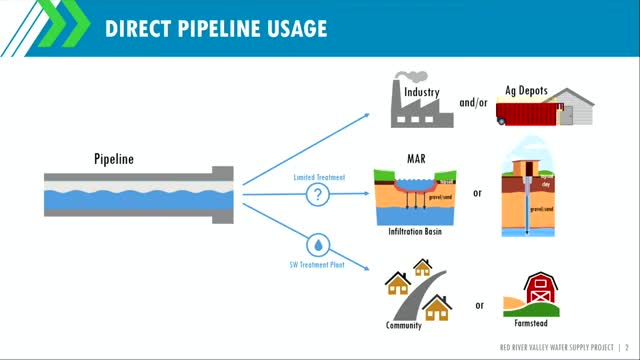Water project sparks debate over treatment and usage options
August 01, 2024 | Fargo , Cass County, North Dakota

This article was created by AI summarizing key points discussed. AI makes mistakes, so for full details and context, please refer to the video of the full meeting. Please report any errors so we can fix them. Report an error »

In a recent government meeting, officials discussed the future of water resources in North Dakota, focusing on the potential use of Missouri River water for various applications, including industrial development and agricultural support. The conversation highlighted the challenges and opportunities presented by the state's water supply, particularly in light of anticipated population growth and climate variability.
Officials noted that while the Missouri River water is of relatively high quality, it may not meet the stringent requirements of the North Dakota Safe Drinking Water Act for direct domestic use. Instead, the water could be utilized for industrial purposes, as many recent industries have shown a preference for non-potable water sources, such as raw water or treated wastewater.
The meeting also addressed the need for agricultural depots to support farmers during peak irrigation seasons. Currently, farmers face difficulties in accessing water, often resorting to inefficient methods that strain local water districts. Proposed solutions include establishing high-capacity fill stations within a five-mile radius of farming operations to streamline water access.
Concerns were raised about the sustainability of local aquifers, with some experiencing depletion due to excessive withdrawal. A comprehensive study by the Department of Water Resources suggested potential managed aquifer recharge strategies, including the use of ponds or injection wells to replenish these vital water sources.
The discussion further explored the logistics of delivering water to communities not directly adjacent to the river. Officials indicated that branch pipelines would be necessary to transport water from the main transmission line to more remote areas, which could complicate treatment processes and water quality management.
Overall, the meeting underscored the importance of strategic planning in managing North Dakota's water resources, particularly as the state prepares for future demands amid changing environmental conditions. The proposed initiatives aim to enhance water availability for both industrial and agricultural needs while ensuring the sustainability of local aquifers.
Officials noted that while the Missouri River water is of relatively high quality, it may not meet the stringent requirements of the North Dakota Safe Drinking Water Act for direct domestic use. Instead, the water could be utilized for industrial purposes, as many recent industries have shown a preference for non-potable water sources, such as raw water or treated wastewater.
The meeting also addressed the need for agricultural depots to support farmers during peak irrigation seasons. Currently, farmers face difficulties in accessing water, often resorting to inefficient methods that strain local water districts. Proposed solutions include establishing high-capacity fill stations within a five-mile radius of farming operations to streamline water access.
Concerns were raised about the sustainability of local aquifers, with some experiencing depletion due to excessive withdrawal. A comprehensive study by the Department of Water Resources suggested potential managed aquifer recharge strategies, including the use of ponds or injection wells to replenish these vital water sources.
The discussion further explored the logistics of delivering water to communities not directly adjacent to the river. Officials indicated that branch pipelines would be necessary to transport water from the main transmission line to more remote areas, which could complicate treatment processes and water quality management.
Overall, the meeting underscored the importance of strategic planning in managing North Dakota's water resources, particularly as the state prepares for future demands amid changing environmental conditions. The proposed initiatives aim to enhance water availability for both industrial and agricultural needs while ensuring the sustainability of local aquifers.
View full meeting
This article is based on a recent meeting—watch the full video and explore the complete transcript for deeper insights into the discussion.
View full meeting
